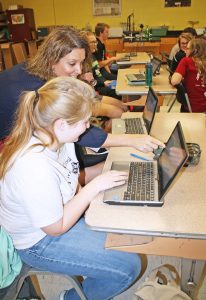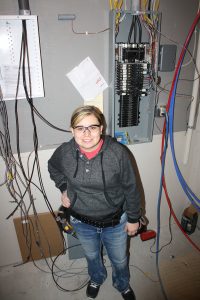Manufacturing: What’s possible?
With today’s workforce short-handed and tomorrow’s anticipated to need higher-level skills, educators and policymakers are trying to increase enrollment at technical schools in the area and across the nation. Here are several examples of those efforts.
Dream It. Do It.
Dream It as a teen, Do It as an adult
 A group of ambassadors from five manufacturers in the Dickinson, N.D., area tells students about their careers to give the students a firsthand account of what it’s like to work in manufacturing.
A group of ambassadors from five manufacturers in the Dickinson, N.D., area tells students about their careers to give the students a firsthand account of what it’s like to work in manufacturing.
“I’ve got too much gray hair” to effectively reach youth, said Guy Moos, president of Baker Boy Baker Boy. “It comes a whole lot better from a young, dynamic individual that’s a rising star” in the company. “We look within our companies for rising stars who haven’t quite hit 30 years old” but have excelled in their work within the five involved companies, and educate them about the other four, Moos said.
The ambassador program was developed by Dream It. Do It. Nebraska, “to help students understand the global challenges and education paths to obtaining skills that lead to good paying careers in manufacturing,” according to the Manufacturing Institute’s website. The Greater North Dakota Chamber purchased rights to the program as part of its Manufacturing Week campaign in October.
The local presentation includes a PowerPoint presentation and video, before the ambassadors share about their companies and available jobs.
“We’re taking action and trying to change the minds of young people” about manufacturing to bolster interest, Moos said. “We’re planting the seeds” for a harvest that will grow over a long term. “We build things, and we are very proud of it, and we want to take that message and share that” with students and educators.
SDMyLife
Preparing youth for life in South Dakota
 Since 2008, SDMyLife has been helping students visualize a future based on their own knowledge, skills and interests, and pair those with real opportunities in South Dakota.
Since 2008, SDMyLife has been helping students visualize a future based on their own knowledge, skills and interests, and pair those with real opportunities in South Dakota.
“The overall goal of SDMyLife is to help students become college-, career- and life-ready,” said Megan Tatum, the SDMyLife and student services specialist of the Division of Career and Technical Education at the S.D. Department of Education.

Chris Bosma, standing, helps a student with the SDMyLife process at Corsica-Stickney High School. Photo by Wendy Royston
Online student interest and ability assessments, as well as academic experiences, guide their exploration of career clusters, leading them through educational and training options. The program also directs them toward scholarship opportunities and prepares them for tests, such as the ACT. They can build resumes and portfolios that will help them enter the school and/or career of their choice.
Through the SDMyLife Network, students can connect directly with business and industry leaders in the state, who upload company profile information and can volunteer their time in a variety of ways, including as career coaches, presenters, company tour guides, and offering internships.
All junior and senior high school students are eligible for the program, and their accounts remain active for five years after they graduate.
Build Dakota
Scholarships help build needed pieces of S.D. workforce
 “Free ride” educations typically are reserved for academic or athletic standouts. But the state of South Dakota, with the help of philanthropist T. Denny Sanford, has created a way for students who may have average grades but a will to succeed to pursue certain technical fields free of charge.
“Free ride” educations typically are reserved for academic or athletic standouts. But the state of South Dakota, with the help of philanthropist T. Denny Sanford, has created a way for students who may have average grades but a will to succeed to pursue certain technical fields free of charge.
“They’re looking at the best of the best,” according to Deni Amundson, program manager for the Build Dakota Scholarship Fund, “but that isn’t necessarily reflected in a high ACT score or a high GPA. We’re really looking at our applicants as a whole person, so those scores certainly play into the big picture, but we’re also looking at individuals with a strong work background in the field that they’re interested in going into—experience in career and technical education courses in high school, or something that shows their aptitude and interest in the career field they’re going into.”
The first Build Dakota scholars are rounding out their first year of school, some of them graduating from diplomaed programs, while others will be back next year, to finish an associate degree. The first five years’ scholarships are funded by a $25 million gift from philanthropist T. Denny Sanford. A second $25 million endowment through the South Dakota Future Fund will fund years six through 10. The program is administered through the Department of Education and has an outside oversight committee. This year’s class consists of 294 students, selected from a pool of 1,250. Fifty-two of those scholars—or 18 percent—are over the age of 25.
The scholarships range in value from $12,000 to $22,000, depending on whether the student is degree- or diploma-seeking, as well as what tools, books and computers are needed. The program does not fund students’ room and board.
Amundson said selection is made by the technical schools, because “they’re in the business. They know the students, they know the things that make a successful student, because they see them every day, so having them have that connection, and them making those decisions really is best.”
Each school is given just over $1 million to award scholarships as they see fit, with a goal of funding at least 300 technical educations each year. The hope is that industry partners will invest in part of the tuitions for some students, who then will be promised jobs at those companies. Students with industry sponsors receive priority for scholarships, since industry partners make it possible to increase the number of scholarships.
Amundson said Build Dakota is “a groundbreaking program that is bringing education and economic development into one program” like never before.
“It’s part of a much larger picture of economic development,” she said. “It’s just one piece of a big puzzle, but it does give employers and students options, and hopefully it’ will help spark some interest in some of these areas that these individuals know they can get a free degree.”
Jamalia Franzen, Mitchell Tech – electrical construction and maintenance

After finishing her training, Jamalia Franzen wants to put her electrical skills to work in her own community of Eagle Butte.
Photo by Wendy Royston
“I want to go home and help,” said Jamalia Franzen, a 2015 graduate of Eagle Butte High School who intends to become the Cheyenne River Indian Reservation’s only certified electrician. “We’re kind of in the middle of nowhere,” so electricians typically have to drive at least 90 miles to work on local projects, increasing costs for homeowners.
Franzen said she is thankful for the dollars that will fund her way through the electrical construction and maintenance program at Mitchell Technical Institute and help her get to work in Eagle Butte.
“If I didn’t have Build Dakota, the Pell Grant would have gone toward my … tuition, but instead I got to use that toward my living expenses,” she said. And a part-time job helps provide her with necessities.
Franzen, who graduated in a class of 70, was among about 35 who left the reservation to get an education, “because everybody (else) said they couldn’t make it financially.”
Only half of those still are in school—a factor of the same family-oriented nature that led Franzen to pursue a trade that would directly benefit her people.
“I don’t think a lot of them even finished the first semester,” she said. “I miss my family a lot … but I talk to them every day on the phone and go home once a month. … Everybody’s not as strong and has as strong of a mindset to stick it out.”
She added that some classmates are taking free basic coursework through Oglala Lakota College on the reservation, but “I didn’t want to stay home. I wanted to go see and do other things” before getting to work.
Tate Jensen, Lake Area Tech – renewable energy
Tate Jensen is willing to relocate within South Dakota after earning his education, as long as he gets to tinker in renewable energy.
“My dad is a mechanic, and I’ve always liked working with my hands,” said the 2015 graduate of Langford High School, so it was no surprise that his SDMyLife experience yielded such professional suggestions as machining, pipe-fitting, welding, truck mechanic and heavy-machinery operator.
“All of those careers apply to my current program,” he said. “I’d say it helped me choose Lake Area and the program of study I am currently in.”
Jensen said the guidance of SDMyLife and his training at LATI culminated in an internship this summer at Big Stone Power Plant in Groton, 90 minutes from home.
SDMyLife helped Jensen “think outside the box” about his future.
“It opens up a whole new realm of possibilities that are specifically related to your interests,” he said.
And the principle of the Build Dakota scholarship motivates him to work harder.
“You’re not the one paying for it, but someone else is, so it’s kind of like you’ve got to do this for not only yourself, but also for them, because they made such a generous donation to your career. You work almost extra-hard, to do your best,” he said.
Plus, the scholarship itself is written in a way that helps students be focused.
“You can’t just party,” he said, because any legal issues result in loss of the scholarship and an obligation to pay it back, with interest. “You’ve got to be careful, because that scholarship is worth more than a few nights of fun where you mess up. It keeps you on track.”
 Dakotafire Get your spark here.
Dakotafire Get your spark here.



